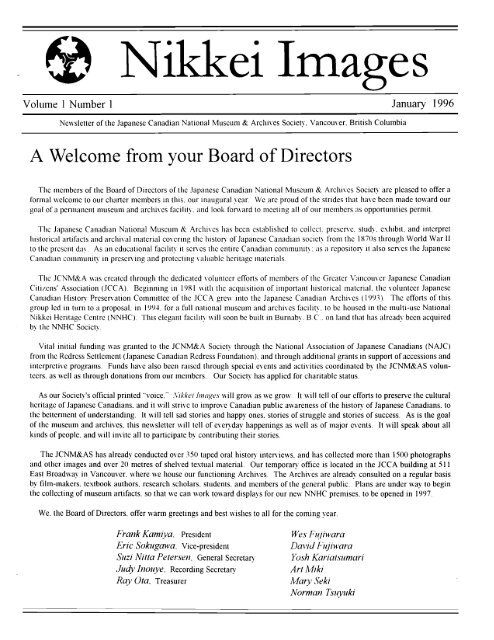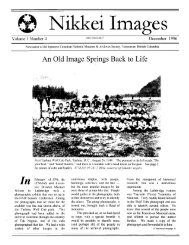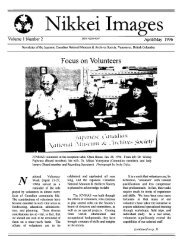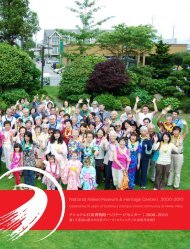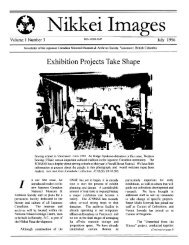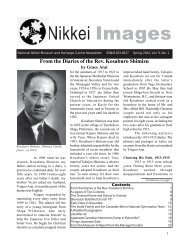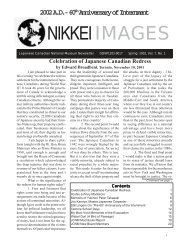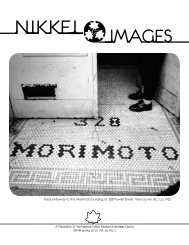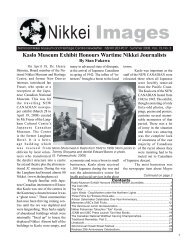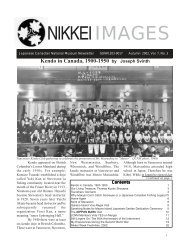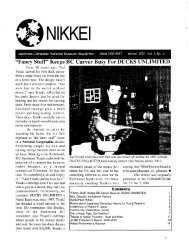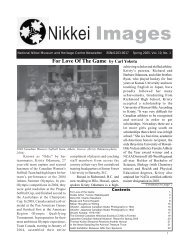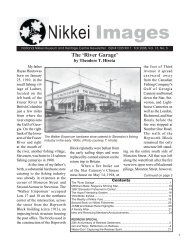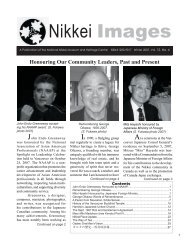Volume 1 No. 1 (PDF) - Nikkei National Museum & Cultural Centre
Volume 1 No. 1 (PDF) - Nikkei National Museum & Cultural Centre
Volume 1 No. 1 (PDF) - Nikkei National Museum & Cultural Centre
You also want an ePaper? Increase the reach of your titles
YUMPU automatically turns print PDFs into web optimized ePapers that Google loves.
~ <strong>Nikkei</strong> Images<br />
<strong>Volume</strong> I Number 1 January 1996<br />
Newsletter of the Japanese Canadian <strong>National</strong> <strong>Museum</strong> & Archiyes Society. Vancouyer. British Columbia<br />
A Welcon1e from your Board of Directors<br />
The members of the Board of Directors of the Japanese Canadian <strong>National</strong> <strong>Museum</strong> & Archives Society are pleased to offer a<br />
formal welcome to our charter members in this. our inaugural year. We are proud of the strides that have been made toward our<br />
goal of a permanent museum and archives facility. and look forward to meeting all of our members as opportunities permit.<br />
The Japanese Canadian <strong>National</strong> <strong>Museum</strong> & Archi\es has been established to collect. preserye. study. exhibit. and interpret<br />
historical artifacts and archival material covering the history of Japanese Canadian society from the IX70s through World War II<br />
to the present da~ As an educational facility it sef\es the entire Canadian communit~: as a repository it also sef\'es the Japanese<br />
Canadian community in presef\'ing and protecting valuable heritage materials,<br />
The JCNM&A was created through the dedicated volunteer efforts of members of the Greater Vancouver Japanese Canadian<br />
Citizens' Association (JCC A) Beginning in lYX I with the acquisition of important historical material. the volunteer Japanese<br />
Canadian History Presef\'ation Committee of the JCC A grew into the Japanese Canadian Archives (1993) The efforts of this<br />
group led in turn to a proposal. in 199-l. for a full national museum and archives facility. to be housed in the multi-use <strong>National</strong><br />
<strong>Nikkei</strong> Heritage <strong>Centre</strong> (NNHC) This elegant facility will soon be built in Burnaby. BC. on land that has already been acquired<br />
by the NNHC Society<br />
Vital initial funding was granted to the JCNM&A Society through the <strong>National</strong> Association of Japanese Canadians (NAJC)<br />
from the Redress Settlement (Japanese Canadian Redress Foundation). and through additional grants in support of accessions and<br />
interpretive programs, Funds have also been raised through special eyents and activities coordinated by the JCNM&AS yolunteers.<br />
as well as through donations from our members, Our Society has applied for charitable status,<br />
As our Society's official printed "voice'" Xikkei Images will grow as we grow It will tell of our efforts to preserve the cultural<br />
heritage of Japanese Canadians. and it will strive to improyc Canadian public awareness of the history of Japanese Canadians. to<br />
the betterment of understanding, It will tell sad stories and happy ones. stories of struggle and stories of success, As is the goal<br />
of the museum and archiyes. this newsletter will tell of eyeryday happenings as well as of major eyents, It will speak about all<br />
kinds of people. and will inyite all to participate by contributing their stories,<br />
The JCNM&AS has already conducted oyer 350 taped oral history intef\'iews. and has collected more than 1500 photographs<br />
and other images and oyer 20 metres of sheh'ed textual materiaL Our temporary office is located in the JCCA building at 511<br />
East Broadway in Vancouver. where we house our functioning Archives, The Archiyes are already consulted on a regular basis<br />
by film-makers. textbook authors. research scholars. students. and members of the general public Plans are under \vay to begin<br />
the collecting of museum artifacts. so that we can work toward displays for our new NNHC premises. to be opened in IYlJ7,<br />
We. the Board of Directors. offer warm greetings and best wishes to all for the coming year.<br />
Frank Kamiya. President<br />
Eric Sokllgawa. Vice-president<br />
Sllzi Nitta Petersel1. General Secretary<br />
Jlldy Inollye. Recording Secretary<br />
Ray Dta. Treasurer<br />
Wes Fl{jiwara<br />
DaviJ Flljiwara<br />
Yosh Kariatsllmari<br />
Art Miki<br />
Mary Seki<br />
<strong>No</strong>rman Tsuyuki
Page 2<br />
<strong>Nikkei</strong> Images<br />
<strong>Nikkei</strong> Images<br />
introducing our new logo<br />
The coyer of our newsletter and the masthead to the left introduce the new<br />
logo of the Japanese Canadian <strong>National</strong> <strong>Museum</strong> & Archi\'Cs Society. designed<br />
by Jcrry Foster. of Surrey. B.C<br />
\'ikkei Ima)!,es IS puhhshed<br />
ljuarterh hv the Japanese Canadian<br />
<strong>National</strong> <strong>Museum</strong> & ArchIves Socld\'<br />
<strong>Volume</strong> 1, <strong>No</strong> 1<br />
January, 1996<br />
EDITOR<br />
Michael C Wilson<br />
ASSISTANT<br />
Shane A. Foster<br />
EDllORlAl. BOARD<br />
(JCNM&AS AdvocaC\ Comnllttee)<br />
Suzi Nitta Petersen<br />
Yosh Kariatsumari<br />
Minnie Hattori<br />
Eric Sokuga\\(}<br />
Mary Seki<br />
<strong>No</strong>rm Tsuyuki<br />
Frank Kamiya<br />
MEMBERSHIP<br />
Suhscription to Nlkkel Images is free \\ith<br />
\,our \'earl\' memhershlp to the<br />
JCNM&J\S<br />
I'annlv $25()()<br />
Individual $2(J(J(J<br />
SelllorlStudent $15(J(J<br />
<strong>No</strong>n-profit ASSOClatlOns $5000<br />
Corporate $](J(J(J(J<br />
JCNM&AS Office:<br />
511 East Broadwa\'.<br />
Vancouver. BC V5T lX4. Canada.<br />
Telephone (604) R74-R090<br />
Fax (604) R74-R164<br />
Mr Foster chose a traditional form of logo. rather than a more contemporary.<br />
"slick" coroporate design The focus on a traditional idea represents the concept<br />
of a museum yisually His design uses traditional Japanese "mon" motifs in a<br />
simple. rhythmic. and yisually pleasing \vay The result is unforgettable - the<br />
goal of an effective logo.<br />
The design uses maple leayes. the symbol of Canada. in a circle. the symbol<br />
of Japan. to collectivcly show that the t\\O countries and cultures have come<br />
together as onc. Strengthening this Idea. the outer circle and the outlines of the<br />
leayes form a slIlgle unbroken line.<br />
Our special thanks arc offered to Mr Foster for his efforts in designing the<br />
logo. and for IllS e,;planation of the rationale behind It.<br />
The Japanese Canadian <strong>National</strong> <strong>Museum</strong> & Archives Society gratefully<br />
acknowledges the support and financial assistance of members. donors. volunteers.<br />
the Japanese Canadian Redress Foundation. the Nallonal Association of Japanese<br />
Canadians. the Japanese Canadian CitIZens Association of Greater Vancouver<br />
and the British Columbia Community Arclmes Assistance Program<br />
The Japanese Canallian <strong>National</strong> <strong>Museum</strong> & Archiws Societ~; is a non-profit<br />
society dedicated to the creation and direction of the Japanese Canadian <strong>National</strong><br />
<strong>Museum</strong> & Archives. The Society has a board of directors (sce page I) and four<br />
working committees The committee membership is as follows:<br />
(I) Ad,()cac~: Yosh Kariatsumari and Suzi Nitta Petersen (co-chairs). Minnie<br />
Hattori. Eric Sokugawa. Mary Seki. <strong>No</strong>rm Tsuyuki. and Frank Kamiya:<br />
(2) Program: Eric Sokugawa (chair). Frank Kamiya. Lana Panko. Minnie<br />
Hattori. Bey Inouye. Naomi Sawada. Judy Inouye. Susan Sirovyak. and Pearl<br />
Williams:<br />
(]) Human Resources: Wes Fujiwara and <strong>No</strong>rm Tsuyuki (co-chairs). Naomi<br />
Sa\\ada. Mary Seki. Pearl Williams. Minnie Hattori. David Yamaura. and Frank<br />
Kamiya:<br />
(-l) Finance: Ray Ota (chair). <strong>No</strong>rm Tsuyuki. Judy lnouye. Suzi Nitta Petersen.<br />
and Frank Kauuya<br />
The Society has three employees:<br />
Mlchael C Wilson. Project Director<br />
Shane A. Foster Archi\'ist and Archiyes Program Coordinator
<strong>Nikkei</strong> Images Page 3<br />
A Brief History of t11e Canadial1 <strong>Nikkei</strong><br />
by Audrey Kobayashi<br />
<strong>Nikkei</strong> hislof\ in Canada<br />
began \\ he;1 people of<br />
J;lpanese origin established a niche<br />
within the system of primary industries<br />
11u1 ~,\lpportcd the Bntish Columbia<br />
-.'-,;ollomy dUflllg the late I ')th Cenlllr\.<br />
All hough J;lpall had had somc contact<br />
with (':mada throut'l\ :hq)\\Tecks along<br />
\\1';,1 .\T, to be the f;,iti"h CoJllIllbia<br />
u" (drill:', Ill' 12;)"1'.' parI of the cen-<br />
IUI\ fnsl lllljl\lgrants i [~,
Page 4<br />
recruited mainly in a specific area of<br />
Japan, with the result that workers from<br />
the same districts, or even the same villages,<br />
were re-grouped in the Canadian<br />
workplace. Some were exploited terribly.<br />
A group of mine workers from<br />
Fukuoka lost several members to starvation<br />
and ill treatment before the<br />
Japanese government inter.ened.<br />
Those who fared better came as sponsored<br />
immigrants (yobeyose) to join<br />
older relatives or neighbours who could<br />
secure contract jobs for them, or provide<br />
them with jobs in small businesses<br />
or on fishing boats.<br />
The early workers in Vancouver<br />
had lived on temporary scows in the<br />
harbour. By the late 1890s, labour contractors<br />
had also begun to buy or lease<br />
land along Powell and adjacent streets.<br />
They built boarding houses for their<br />
workers, and diversified their interests<br />
to retail and other services, including<br />
bath houses, barber shops and billiard<br />
halls. Their activities soon expanded<br />
throughout the entire province, where<br />
they obtained contracts in logging,<br />
milling, fishing, mining, railway or<br />
agricultural ventures in remote areas.<br />
A new immigrant would be met at<br />
the dock by his employer/sponsor, most<br />
likely a ken-jin (person from the same<br />
prefecture) and be taken immediately to<br />
the house that boarded others from the<br />
same area. In this way, even relationships<br />
that had already been established<br />
in Japan became stronger, and the kenjinkai<br />
(prefectural association) became<br />
onc of the most important building<br />
blocks of at least the first generation of<br />
<strong>Nikkei</strong>. After that first night the immigrant<br />
might return to the same boarding<br />
house many times in search of new<br />
work, or simply companionship.<br />
During this time, very few Issei<br />
women entered Canada. Those less fortunate<br />
were imported by unscrupulous<br />
operators who used them as prostitutes.<br />
Life was more honoured, ifjust as difficult,<br />
for wives and relatives of entrepreneurs.<br />
They were required to support<br />
the family enterprise by running<br />
the boarding houses, stores and camps,<br />
cooking and cleaning for large gangs of<br />
men. Many worked in remote camps<br />
where the luxury of female companionship<br />
found on Powell Street was not<br />
available. The first such Issei woman<br />
was Yo Oya, who arrived in 1887 and,<br />
together with her husband, Washiji. ran<br />
a business on Powell Street for many<br />
years. In 1889, their son, Katsuji. became<br />
the first Nisei (second generation)<br />
born in Canada.<br />
Immigration increased after the<br />
turn of the century'. In Japan, the end of<br />
the Russo-Japanese War in 1905 had<br />
created unemployment exacerbated by<br />
devastating crop failures in 1906. Although<br />
the extant records are eontradicvarious<br />
official and<br />
unofficial measures were tried<br />
to limit both the numbers and<br />
the civil rights of <strong>Nikkei</strong> and<br />
~herso~aSiallbac~gr:llld ..<br />
tory', it is estimated that until 1905 some<br />
15,000 men had worked in British<br />
Columbia for vary'ing, usually short, periods<br />
of time. To maximize their earnings,<br />
they moved back and forth between<br />
Canada and the United States:<br />
others entered via the Hawaiian sugar<br />
plantations, with no official record. Between<br />
1905 and 1907, the number was<br />
augmented by more than 4,000. Then<br />
in 1906, the United States, under political<br />
pressure, followed amendments to<br />
immigration policy with a "Gentlemen's<br />
Agreement" that served virtually to halt<br />
Japanese immigration. In 1907-08<br />
nearly 8,000 set their destination for<br />
Canada, where the boom of sawmill<br />
building was beginning to tail off.<br />
These labourers were deeply resented<br />
by other Canadians. From the<br />
turn of the century, various official and<br />
unofficial measures were tried to limit<br />
both the numbers and the civil rights of<br />
<strong>Nikkei</strong> and others of asian background.<br />
Virulent racism, fundamental to Canadian<br />
society, climaxed on 7 September<br />
<strong>Nikkei</strong> Images<br />
1907. Bolstered by a general public<br />
clamour to deny the rights and existence<br />
of asians in Canada, a mob of 5,000 attacked<br />
the Chinese immigrant area of<br />
Vancouver, and surged on to Powell<br />
Street causing extensive damage.<br />
After the riot asian workers staged<br />
a general strike amidst continued racist<br />
expressions from the white public. A<br />
Royal Commission undertaken by W.L.<br />
Mackenzie King subsequently provided<br />
some compensation for physical damages,<br />
but maintained that the "problem"<br />
could be solved only by limiting the<br />
number of asian faces on Canada's<br />
streets. The result was the Hayashi<br />
Lemieux "Gentlemen's Agreement" in<br />
1908, which severely limited further immigration<br />
except for returning immigrants<br />
and their families, commercial<br />
and official travellers, clerics and students.<br />
Until this time, many of the men<br />
had moved back and forth between<br />
Canada and Japan, often on a seasonal<br />
basis. The new restrictions, combined<br />
with economic circumstances, made<br />
such movement difficult and many, especially<br />
those without prospects of land<br />
ownership in Japan, made the decision<br />
to remain permanently in Canada.<br />
Thence began the "picture bride" system,<br />
a variation on the tradition of arranged<br />
marriage whereby prospective<br />
partners exchanged photographs as a<br />
form of betrothal. The marriage took<br />
place in Japan in the absence of the<br />
groom, thus allowing a legal wife to enter<br />
the country. From 1908 to the mid<br />
1920s, some 5,000 young women entered<br />
Canada in this way.<br />
The life of such a woman was always<br />
difficult. While adapting to marriage<br />
with a man she had likely never<br />
met, she was expected to work either in<br />
a family enterprise or in waged labour.<br />
She had few choices: domestic work in<br />
homes of wealthy white families, or line<br />
work in canneries generally comprised<br />
the jobs to which non-white women had<br />
access. A few joined husbands who had<br />
managed to save enough to buy farms,
<strong>Nikkei</strong> Images<br />
Page 5<br />
and these were considered fortunate,<br />
With the establishment of families<br />
came a need for schools, By the turn of<br />
the century. classes were offered on<br />
Powell Street by Methodist or Anglican<br />
missionaries: later. the Nisei attended<br />
nearby Strathcona School. The largest<br />
group of early students consisted of<br />
teenaged boys, brought to Canada by fathers<br />
or older brothers. who worked during<br />
the day as apprentices or sllOp assistants<br />
and took English classes at night.<br />
The first Japanese language school for<br />
the Nisei was established in Vancouver<br />
in 1906, Although many chose to send<br />
their children to Japan for all or part of<br />
their educations. the number of Japanese<br />
language schools had grown to over 60<br />
by the 1940s,<br />
The community-building process<br />
was hastened by World War I. Smaller<br />
communities became established<br />
throughout the province, especially<br />
along the coast. High wages and a demand<br />
for labour during and immediately<br />
after World War 1allowed many to<br />
become established in busmess, to pay<br />
off fishing boats, or to purchase agricultural<br />
land in the Fraser and Okanagan<br />
Valleys or on Vancouver Island, In particular,<br />
the <strong>Nikkei</strong> were instrumental in<br />
creating the successful berry farms of<br />
the Fraser Valley,<br />
Some 196 Japanese Canadians also<br />
fought for the Canadian forces during<br />
World War I. Fifty-four were killed and<br />
92 wounded, Their lives were testament<br />
to the fact that the <strong>Nikkei</strong> were by then<br />
Canadian in every sense, Yet it was not<br />
enough, for other British Columbians<br />
continued to speak of the "Yellow<br />
Peril", and deny fundamental human<br />
rights such as the franchise, and the<br />
right to purchase Crown Lands, to hold<br />
public office, to hold professional licences<br />
or to be employed in the public<br />
service, Less official means of discrimination<br />
occurred in restaurants. theatres<br />
and schools. When Chitose Uchida became<br />
the first <strong>Nikkei</strong> to graduate from<br />
the University ofB.C. in 1916, she was<br />
also the first of many who would find<br />
Japanese prospective brides on board ship, facing an uncertain destiny (date<br />
not known). Japanese Canadian Centennial Project Collection. JCNM&A.<br />
that their diplomas failed to provide<br />
them with appropriate jobs.<br />
As the economy weakened during<br />
the I920s. public resentment became<br />
more and more open. In 1928 the Government<br />
yielded to public pressure and<br />
reactivated the Hayashi-Lemieux<br />
Agreement. with a new annual limit of<br />
ISO. of whom no more than half could<br />
be female, The Japanese-Canadian<br />
population declined from that time, as<br />
many of the original Issei returned to<br />
Japan. Some had never intended to stay<br />
in Canada; others gave up hope against<br />
the tide of racism.<br />
During the 1930s, the community<br />
became more firmly established, and<br />
continued to grow through natural increase.<br />
There were 23,000 people in<br />
1941. of whom 22,000 were in the<br />
province of British Columbia, Fully<br />
I Some 196 Japanese Canadians<br />
I ... fought for the Canadian<br />
forces during World War I.<br />
Fifty-four were killed and 92<br />
wounded.<br />
'-------------<br />
I<br />
--<br />
17,400, or 80%, were Canadian citizens,<br />
the balance landed immigrants of<br />
Japanese citizenship. Over 50% of the<br />
population was under age 30, There<br />
were 8.300 people in the workforce,<br />
half in the areas of lumber production,<br />
fishing and agriculture. This was an<br />
established community strongly committed<br />
to Canada. their home.<br />
Canada declared war with Japan<br />
on 7 December 1941. Few Japanese<br />
Canadians held any political allegiance<br />
to Japan. but they felt anguish to realize<br />
that hostilities existed between the two<br />
countries, and immediate fear that simmering<br />
resentment would break out<br />
into hostility against them in Canada.<br />
The events of 1941 , however, showed<br />
once and for all the depth of Canadian<br />
racism and the precarious nature of the<br />
<strong>Nikkei</strong> existence.<br />
Years of pressure by politicians<br />
and journalists had preceded the war.<br />
British Columbia politicians - Vancouver<br />
Alderman Halford Wilson, Premier<br />
T.D. Pattulo, MP A. W. Neill,<br />
Cabinet Minister and MP Ian Mackenzie<br />
- had mounted a campaign to keep<br />
asian Canadians from the armed forces.
Page 6<br />
<strong>Nikkei</strong> Images<br />
quickly detained, and most later sent to<br />
prisoner-of-war camps in <strong>No</strong>rthern Ontario.<br />
All property of persons residing<br />
in Japan was confiscated. Next, however.<br />
in aetions that showed the government's<br />
true racist nature, attention was<br />
turned to Canadian citi/.ens. Some<br />
I. U 7 fishing boats owned by Japanese<br />
Canadians were impounded. and suffered<br />
inestimable and irreparable damage<br />
through subsequent neglect. With<br />
cold deliberacy the government. under<br />
the auspices of the RC. Securities<br />
CommiSSIOn. put in place a plan for the<br />
uprootlllg and dispossession of the<br />
Nikkel cOliimunitv.<br />
Japanese Canadian evacuecs leavin~ Vancouvcr bv train. Cl 1
<strong>Nikkei</strong> Images<br />
Page 7<br />
Early in the summer, the trains<br />
began to roll, their windows blacked<br />
out as they carried thousands of<br />
Japanese Canadians to unknown<br />
destinations. About 700 men were sent<br />
to prisoner-of-war camps, and about<br />
2,100 to road camps, where they were<br />
used as forced labour for roadbuilding<br />
projects. The largest group. about<br />
12,000 which included the families of<br />
the men in the camps. were sent to<br />
concentration camps in the British<br />
Columbia interior. These were either<br />
reclaimed ghost towns or hastily<br />
erected camps, consisting at first of<br />
tents, then of shacks made of green<br />
lumber that shrank in the subsequent<br />
winter to provide little provision<br />
against the mountain cold. About<br />
4.000 were sent in family groups to the<br />
prairie provinces, where they worked<br />
the sugar beet farms under severe<br />
conditions. Some fared reasonably well<br />
there; others were treated as slaves.<br />
There were also about 4,200 who were<br />
not incarcerated: 2,000 were already<br />
outside the designated area; 1.200 were<br />
wealthy enough to establish selfsupporting<br />
camps in the interior; about<br />
1.000 managed to join family members<br />
in Ontario and Quebec. All. of course.<br />
were subject to curfew and registration.<br />
had belongings confiscated. and were<br />
disallowed free travel.<br />
Thus dispersed, the <strong>Nikkei</strong><br />
resolved to wait out the war, hoping<br />
that the end of hostilities would end<br />
their conditions of apartheid. It was not<br />
to be so. In 1943. still not allowed to<br />
return to the coastal area, those who<br />
could find places to relocate East of the<br />
Rockies were allowed to do so. A<br />
strong network developed within the<br />
community to find places for its<br />
members. They were supported by a<br />
variety of religious organizations such<br />
as the YMCA, and a group of<br />
concerned citizens, The Cooperative<br />
Committee on Japanese Canadians,<br />
who lobbied the government. while<br />
arranging employment and schools,<br />
and gathering food and clothing.<br />
Hope diminished as the Securities<br />
Angler Prisoner-of-War Camp, Angler, Ontario. ca. 1942-1946.<br />
Fonds, JCNM&A, 94/48.003a-c.<br />
Commission began selling off property<br />
and possessions. In 1944, those still in<br />
the camps were told to remove<br />
themselves permanently to the East. or<br />
sign papers renouncing their Canadian<br />
citizenship and agreelllg to<br />
"deportation" to Japan. Lacking<br />
knowledge. means of support and<br />
employment. and afraid of what they<br />
would face in the East, about 10,000<br />
signed. They were encouraged by being<br />
told that they could rescind their<br />
signatures once they had made<br />
arrangements: signing was thus a<br />
means of buying time. Many hoped<br />
that when the war would end, the<br />
papers would be irrelevant.<br />
The war did end, in August 1945.<br />
But its conclusion made little difference<br />
for the conditions of Japanese<br />
Canadians. On 5 October 1945. the<br />
Canadian Parliament enacted the<br />
<strong>National</strong> Emergency Transitional<br />
Powers Act. which allowed the original<br />
provisions under the War Measures Act<br />
to be continued. Japanese Canadians<br />
were told that they would never be<br />
allowed to return to British Columbia;<br />
Joe Hayaru<br />
that they would not be given civil<br />
rights: that they must accept a pittance<br />
for their lost property (most of the<br />
proceeds having been used for their<br />
"support" while incarcerated); and that<br />
those remaining in the camps would<br />
indeed be exiled to Japan.<br />
Until this time, no Japanese<br />
Canadian had been charged or<br />
convicted of any crime against the<br />
wartime interests of the nation. There<br />
was no evidence of fifth-eolumn<br />
activity, and no overt expression of<br />
allegiance to Japan. Unconvicted. they<br />
were sentenced on the basis of their<br />
"race," so that British Columbia could<br />
become a province cleansed of people of<br />
Japanese ancestry.<br />
The removal legislation was later<br />
rescinded. but not before more than<br />
4,000 people, of whom more than half<br />
were children born in Canada, were<br />
exiled. Those not expelled were sent to<br />
other parts of Canada, where they were<br />
prevented from re-settling in close<br />
proximity to one another. After 1946,<br />
<strong>Nikkei</strong> were gradually granted the
- ------ -------------~----- --------------------------------------------------<br />
Page 8<br />
<strong>Nikkei</strong> Images<br />
rights of citizenship. In 19-t7. they<br />
were permitted to purchase real<br />
property: in 19-t8. they were allowed to<br />
vote federally: in 19-t9. they were<br />
allowed to vote in British Columbia.<br />
On 31 March 19-t9. the last of the<br />
restrictions under the War Measures<br />
Act was lifted. and they were allowed to<br />
travel freely and to return to live in<br />
British Columbia. This freedom was<br />
indeed a Pyrrhic victory.<br />
and human rights groups who provided<br />
support. The War Measures Act was<br />
revoked in April 1988. The redress<br />
settlement. announced in cabinet on<br />
the 22nd of September. included an<br />
acknowledgement of injustice.<br />
individual payments of $21.000 to<br />
approximately 17.000 people. a<br />
community fund of $12.000.000.<br />
revoking of criminal records of those<br />
charged under the War Measures Act.<br />
re-institution of citizenship rights to<br />
those exiled to Japan. and the creation<br />
of a Canadian Race Relations<br />
Foundation. When established. it will<br />
be a most fitting expression of the long<br />
battle for human rights that has marked<br />
the history of the <strong>Nikkei</strong>.<br />
Postscript<br />
Since the 19-tOs. Japanese<br />
Canadians ha\'e rc-built their lives and<br />
their community. About a quarter of<br />
those exiled managed to return to<br />
Canada. starting during the 1950s.<br />
Other immigrants have come in<br />
relatively small numbers. and now<br />
make up about 25'Yo of the current<br />
population of ()5.000 Many of today's<br />
<strong>Nikkei</strong> - third. fourth. fifth. and sixth<br />
generations known as sansei. yonsei.<br />
gosei. and rokusei - are the product of<br />
intermarriage with members of other<br />
ethnocultural groups. Most of the<br />
population today is centred ll1<br />
Vancouver and Toronto. In contrast to<br />
their Issei forbears. contemporary<br />
<strong>Nikkei</strong> are urban and highly educated.<br />
During the 1950s and 1960s.<br />
Japanese Canadians were too busy<br />
rebuilding their shattered lives to worry<br />
much about redress for their<br />
experiences. The Nisei generation. in<br />
addition. felt ambivalent about<br />
speaking out and perhaps risking their<br />
new-found freedom. This situation<br />
began to change in 1977. when<br />
celebration of the centenary caused a<br />
coming-together of the community. and<br />
when discussions of redress began to<br />
reach the wider community. For the<br />
next decade. the <strong>National</strong> Association<br />
of Japanese Canadians worked on<br />
behalf of their community to negotiate<br />
a redress settlement. achieved in 1988<br />
after a difficult battle. and tremendous<br />
effort that involved the coordination of<br />
many Japanese Canadians. as well as<br />
other communities and religious. labour<br />
Yamato Photographers Group. Fifth Exhibition. Vancouver. B.c. ('7). August 1.<br />
1915. Shuklchi .1katsuka Col!('ction. JC.\'.\I(f..~l. 9110.006a-c<br />
EVENTS CALENDAR<br />
JCNM&AS FUNDRAISING LEAP YEAR DANCE<br />
Western-J.:/ondike Theme<br />
Saturday. February 2-t. 1996 7:30 pm to 1200 am<br />
Capitol Hill Community Hall.<br />
361 South Howard Avenue. Bumaby. B.C.<br />
(at E. Hastings Street; Big "0" Tire sign on corner)<br />
Tickets: $16.00/person (includes buffet s~vle hors d 'oeuvres and dessert)<br />
Tickets: Frank Kamiya. 929--t-t76: Suzi Petersen. 274-5102:<br />
Minnie Hattori. 591-3177


